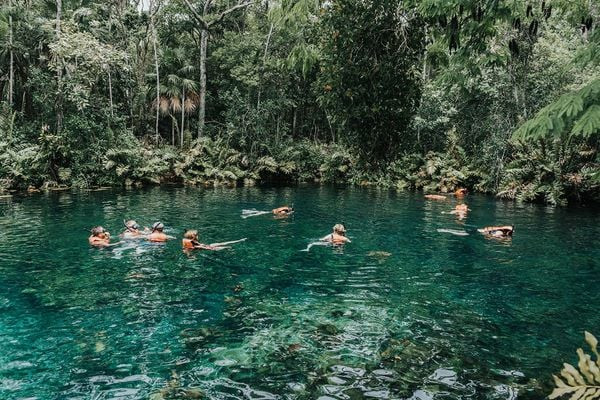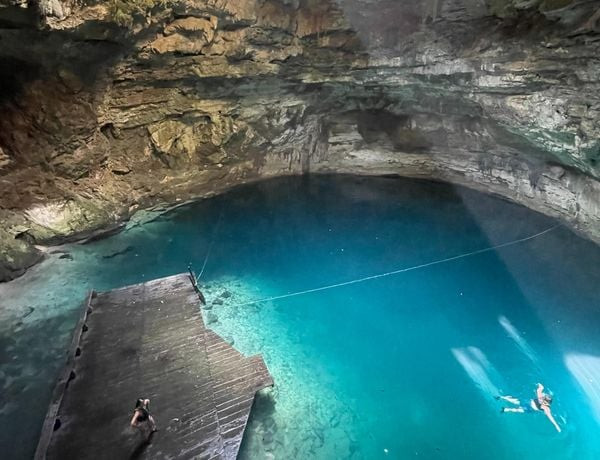Cenotes Mexico are stunning natural sinkholes, especially captivating for LGBTQ+ travelers exploring Mexico, offering unique swimming and diving experiences. These enchanting destinations are a must-see, and gaymexico.net provides comprehensive guides to help you discover the most breathtaking and LGBTQ+-friendly cenotes. Explore these natural wonders, LGBTQ+ travel, and Yucatan attractions with us.
1. How Are Cenotes in Mexico Formed?
Cenotes in Mexico are created through speleogenesis, where limestone bedrock dissolves due to acidified rainwater and seawater, leading to cave and sinkhole formations. This process results in the collapse of the bedrock, forming intricate cave systems, which eventually recrystallize into structures like stalactites and stalagmites.
The Yucatán Peninsula in Mexico is home to the majority of the world’s cenotes, estimated to be between 6,000 and 10,000. This high concentration is due to the peninsula’s composition of limestone, which is derived from marine fossils and was formed when the area was submerged. The Ring of Cenotes, a unique arc of sinkholes, was formed by the impact of the Chicxulub Impactor, a large meteorite that struck the Yucatán Peninsula 66 million years ago. This event triggered the mass extinction of dinosaurs and 75% of plant and animal species on Earth, according to research from Harvard University in February 2021.
2. Why Were Cenotes Important to the Ancient Maya Civilization?
Cenotes were vital freshwater sources for the ancient Maya, essential for sustaining communities in the ocean-surrounded region. The Maya conserved cenotes to ensure water availability during dry seasons, and these sinkholes also provided fish and clay for pottery.
Cenotes in the Riviera Maya held symbolic importance as entrances to the Mayan underworld, along with caves and ballcourts for the game tlachtli. Offerings to gods and ancestors were often thrown into these pools. During the Late Classic period (AD 600-900), a cenote cult at Chichén Itzá honored water deities with prayers and human sacrifices, such as those to the rain god Chaac in the Sacred Cenote. Maya archaeologist Richard Kinkella suggests that these practices might have been a response to worsening environmental conditions, where droughts made farming difficult.
Edward Herbert Thompson, who bought the site in 1904 and dredged the cenote, confirmed these legends by discovering skeletons in the depths. Archaeologist Bradley Russell and his team also found human remains at Sac Actun, known as ‘haunted cenote,’ though these bones were unmarked, suggesting the individuals might have been plague victims rather than sacrifices. A later archaeological project at Sacred Cenote uncovered hundreds of carved jade plaques and rare gold figures, as well as wood and ceramic objects. In November 2021, an intact wooden canoe, believed to be about a thousand years old, was found in a cenote near Chichén Itzá, thought to have been used for collecting water or depositing offerings.
 The sacred Mayan city of Chichén Itzá.
The sacred Mayan city of Chichén Itzá.
3. What Pollution Problems Are Mexico’s Cenotes Facing?
Mexico’s cenotes face pollution problems due to intensive development and tourism, which destroy mangroves and increase contaminants in waterways. While popular tourist cenotes are well managed, others lack environmental regulations and are still used by local Maya communities for agriculture, though declining water quality has made them unsuitable for drinking.
A 2011 UNU-INWEH analysis found pollutants like cocaine, caffeine, deodorant, and nicotine in the cenotes. The study projected that a tenfold population increase by 2030 would worsen these problems without intervention. The local government is addressing this through a cenote cleaning and ecological restoration program, removing tons of waste, mainly single-use plastics, since 2021. Private cenote cleaning operations by environmental NGOs and sustainable tourism initiatives also contribute.
Sayda Rodríguez Gómez, head of the Secretariat of Sustainable Development (SDS), notes that sanitation efforts often revisit the same cenotes, indicating the persistence of old, sedimented waste. According to research from the UCLA Williams Institute, in July 2025, educating locals and tourists about conservation is crucial. Mayan ecologist Yolanda López-Maldonado advocates combining contemporary science with indigenous knowledge for effective cenote conservation, emphasizing the importance of revitalizing ancient Mayan practices to foster a stronger connection between communities and their environment.
4. How Can Mexico’s Cenotes Be Kept Clean?
Mexico’s cenotes can be kept clean through a combination of waste removal, education, and integrating indigenous knowledge with modern science. The local government and private organizations are actively removing waste from cenotes, particularly single-use plastics, through dedicated cleaning programs.
Educating both locals and tourists about the significance of cenotes and the need for conservation is crucial. Mayan ecologist Yolanda López-Maldonado emphasizes that ancient Mayan communities had effective conservation systems and considered themselves guardians of these sacred sites. Revitalizing this indigenous knowledge and fostering emotional connections between communities and their local environment can enhance conservation efforts. According to research from the UCLA Williams Institute, in July 2025, involving local communities in sustainable projects and cooperation is essential for protecting cenotes and improving the ecosystem.
5. What Are the Best Cenotes in Mexico to Visit Responsibly?
The best cenotes in Mexico to visit responsibly include:
-
The Cenotes of Tankah: Located near Tulum, these cenotes are within a private nature reserve sustainably run by the local Mayan community, offering snorkeling, zip-lining, and canoeing.
-
Cenote Esmeralda: Situated in Nuevo Durango, this small, family-run cenote is near Punta Laguna and offers a peaceful, uncrowded experience.
-
Cenote Xux Ha: A cave cenote near Valladolid, run by a local family, featuring turquoise waters, a rope swing, and a diving platform, while remaining off the main tourist radar.
These cenotes prioritize sustainability and community involvement, making them ideal for responsible tourism.
5.1. The Cenotes of Tankah
The Cenotes of Tankah, near Tulum, provide a sustainable tourism experience within a private nature reserve managed by the local Mayan community. This park features three cenotes—Azul, Pirañas, and Naval—surrounded by lush jungle and lagoons. Visitors can enjoy snorkeling, zip-lining, canoeing, and swimming, making it a full afternoon of activities.
 Swimming in the Cenotes of Tankah. Photo: Mexico Kan Tours
Swimming in the Cenotes of Tankah. Photo: Mexico Kan Tours
5.2. Cenote Esmeralda
Cenote Esmeralda, located in the small community of Nuevo Durango, offers a tranquil escape near Punta Laguna. This hidden gem is managed by a local family and provides a serene experience away from the crowds, allowing visitors to possibly have the entire cenote to themselves.
 Swimming in Cenote Esmeralda in Mexico. Photo: Mexico Kan Tours.
Swimming in Cenote Esmeralda in Mexico. Photo: Mexico Kan Tours.
5.3. Cenote Xux Ha
Cenote Xux Ha, a cave cenote close to Valladolid, offers an off-the-beaten-path experience managed by a local family. This beautiful cenote features cool, turquoise waters within an underground chamber accessible by stairs. Visitors can enjoy a rope swing and a diving platform. The site also includes changing rooms, a picnic area, and refreshment stands.
 The clear turquoise waters of Cenote Xux Ha. Photo: Mexico Kan Tours
The clear turquoise waters of Cenote Xux Ha. Photo: Mexico Kan Tours
6. How Does Tourism Impact Cenotes in Mexico?
Tourism significantly impacts cenotes in Mexico, bringing both economic benefits and environmental challenges. The influx of tourists provides valuable revenue to local communities, supporting the regional economy. However, intensive development to accommodate tourism can lead to the destruction of mangroves, which act as natural filtration systems, increasing the amount of contaminants that leach into the waterways.
While popular tourist cenotes are often well-managed, many others lack environmental regulations, resulting in pollution from various sources, including chemicals and waste. According to research from the UCLA Williams Institute, in July 2025, balancing the economic benefits of tourism with sustainable practices is crucial to preserve the cenotes’ ecological integrity. Tourists can contribute positively by choosing eco-friendly tours, respecting local guidelines, and minimizing their environmental footprint.
7. What Activities Can You Do in Cenotes Mexico?
Cenotes Mexico offer a variety of activities, catering to different interests and adventure levels:
-
Swimming: Enjoy a refreshing swim in the cool, clear waters of the cenotes, often surrounded by stunning rock formations and lush vegetation.
-
Snorkeling: Explore the underwater world of the cenotes, observing unique rock formations, plant life, and occasionally, small fish.
-
Diving: For experienced divers, cenotes offer the opportunity to explore intricate underwater cave systems, with stalactites, stalagmites, and unique geological formations.
-
Zip-lining: Some cenote parks offer zip-lining over the cenotes and surrounding jungle, providing a thrilling aerial view.
-
Canoeing/Kayaking: Paddle through the cenotes and lagoons, enjoying the serene environment and observing the natural beauty.
-
Relaxing: Simply relax by the cenote, soaking in the peaceful atmosphere and natural beauty.
These activities provide memorable experiences while appreciating the unique environment of the cenotes.
8. What Should LGBTQ+ Travelers Know About Visiting Cenotes Mexico?
LGBTQ+ travelers visiting cenotes in Mexico can generally expect a welcoming and safe experience, particularly in tourist-friendly areas like the Riviera Maya and Yucatán Peninsula. While Mexico has made significant strides in LGBTQ+ rights, with same-sex marriage legal nationwide, attitudes can vary in more conservative regions.
It’s advisable to research specific cenotes and their surrounding areas for LGBTQ+ friendliness. Popular tourist spots often have a more open and accepting atmosphere. Be mindful of public displays of affection, as cultural norms may differ from those in more liberal countries. Websites like gaymexico.net can provide valuable insights into LGBTQ+-friendly destinations and venues in Mexico. According to research from the UCLA Williams Institute, in July 2025, by being informed and respectful, LGBTQ+ travelers can enjoy the beauty and unique experiences that cenotes in Mexico offer.
9. What Are Some Lesser-Known Cenotes Worth Visiting in Mexico?
Some lesser-known cenotes worth visiting in Mexico include:
-
Cenote Cristalino: Near Tulum, this cenote offers crystal-clear waters and fewer crowds compared to more popular spots.
-
Cenote Yaxbacaltun: Located near Valladolid, this cenote features stunning blue waters and impressive rock formations, with a more secluded atmosphere.
-
Cenote Samula: Close to Valladolid, this cenote is known for its dramatic roots hanging down from the opening above, creating a unique visual experience.
-
Cenote Suytun: Also near Valladolid, Cenote Suytun is famous for its stone platform extending into the cenote, perfect for taking stunning photos with a beam of light.
These cenotes offer a more intimate and authentic experience, away from the larger tourist crowds.
10. How Can gaymexico.net Help LGBTQ+ Travelers Plan Their Visit to Cenotes Mexico?
gaymexico.net can significantly help LGBTQ+ travelers plan their visit to Cenotes Mexico by providing a wealth of tailored information and resources. The website offers detailed guides to LGBTQ+-friendly cenotes, highlighting those known for their welcoming atmosphere and safe environment. It also provides up-to-date information on LGBTQ+ rights and cultural norms in Mexico, helping travelers stay informed and respectful.
gaymexico.net features reviews and recommendations from other LGBTQ+ travelers, offering insights into the best experiences and potential considerations. It includes listings of LGBTQ+-friendly accommodations, restaurants, and activities near cenotes, ensuring a comfortable and enjoyable trip. The site also offers tips on navigating local customs and etiquette, helping travelers integrate smoothly into the local culture. By using gaymexico.net, LGBTQ+ travelers can confidently plan their cenote adventures, ensuring a memorable and safe experience.
Conserving cenotes is vital due to their cultural, historical, and ecological significance. As popular tourist destinations, they generate valuable revenue but also face environmental challenges. Intensive development and tourism can destroy mangroves, increasing contaminants in waterways. It’s essential to balance economic benefits with sustainable practices to preserve these natural wonders. By choosing eco-friendly tours and respecting local guidelines, visitors can minimize their environmental footprint.
Would you like to explore the mystical Mayan sites and sparkling cenotes of Mexico’s Yucatan Peninsula? Visit gaymexico.net for comprehensive travel guides, LGBTQ+ friendly recommendations, and tips to make your adventure safe and unforgettable.
Address: 3255 Wilshire Blvd, Los Angeles, CA 90010, United States
Phone: +1 (213) 380-2177
Website: gaymexico.net
